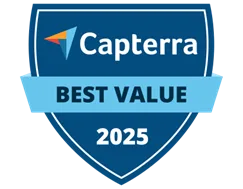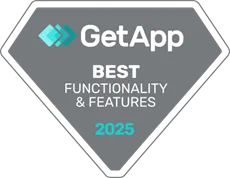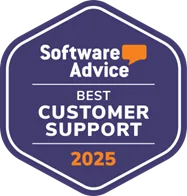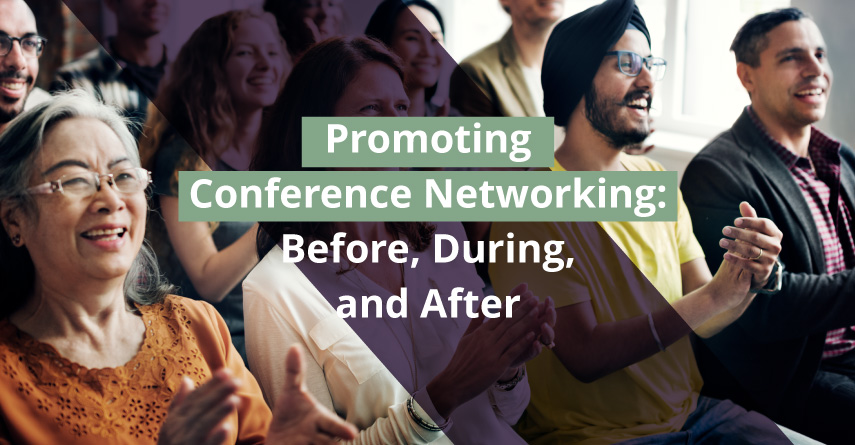
A new year means a new set of events to plan and host—and you want to make sure that they’re better and more successful than the previous year’s! For conferences, a great way to improve your existing event plan is to facilitate networking among your attendees and their qualified leads.
To ensure that your conference appropriately prioritizes networking, begin brainstorming how you’ll do so during the event planning process. To help you get off on the right foot, we’ll cover why networking is important and how to promote it before, during, and after your conference.
Why is networking important for conferences?
The main goals of conference-style events are knowledge sharing and acquisition, professional development, and promotion and marketing. Since these gatherings generally include experts and professionals with common interests, networking allows attendees to derive more value from the event—such as gaining insights from like-minded individuals on how to improve their businesses or enhance their professional knowledge and growth.
Plus, business and association professionals can seize the opportunity to form relationships with qualified leads, increasing their return on investment (ROI) for attending the event.
Stages of Promoting Conference Networking
1. Before
If you’ve planned an event previously, you know how important it is to set your conference up for success weeks to months before it takes place. The same goes for networking—if you want event attendees to network with one another successfully, you need to put in the work to help them do so.
Start by understanding your conference’s audience and attendees. Consider the following questions for a good jumping-off point:
- What types of individuals will attend your conference?
- Why are they attending your conference?
- What subjects are these individuals interested in?
- Who would these individuals like to or most benefit from networking with?
Use this information to create personas of your typical conference attendees and tailor networking opportunities accordingly.
Additionally, it can be worthwhile to invest in tools that make networking and relationship-building easier for your attendees. Event management software allows your staff members to take the stress out of planning and execution through features such as:
- Online registration
- Schedules and agendas
- Event location maps
These tools may also include social features like attendee directories and messaging solutions, allowing event attendees to search for other individuals they’re interested in connecting with and message them to set up a meeting during the conference.
2. During
The brunt of networking will occur during your conference. Empower attendees to connect by offering activities specifically meant to facilitate relationship-building. Some of these include:
- Welcome reception. These are usually casual gatherings that occur on the first day of the conference to help attendees begin making connections with each other.
- Panels. Feature important and interesting guest speakers at your event to host a panel, where they discuss industry best practices. For example, if your association’s conference is focused on fundraising, you might invite authors of fundraising books to share their expertise. Then, host a moderated Q&A session, where attendees can connect with experts by asking questions.
- Mentorship sessions. A mentorship session is a more intimate, often one-on-one, activity where a seasoned professional provides a newer professional with advice and guidance. These sessions can lead to long-term mentorship relationships that benefit both individuals.
- Speed networking. This activity is similar to speed dating, where you give attendees a limited amount of time to get to know one another. With speed networking, attendees usually exchange business cards and leave with the contact information of other professionals they’d like to form deeper connections with.
If you’re concerned about prioritizing networking but your event is virtual or hybrid, don’t worry—according to Swaim Strategies, remote events still allow you to build community and facilitate relationship-building between attendees. The right event management tools will help you keep virtual attendees engaged in your activities with gamification, notifications, and more.
Plus, don’t forget to reach out to your organization’s leads during the conference. Take the time to locate important individuals, introduce yourself, and schedule meetings to increase the value of your event for your organization.
3. After
Even after your conference ends, you can encourage attendees to follow up on the new relationships they’ve formed. Send follow-up emails reminding them to leverage their new connections to see greater professional success. You might even include templates for emails or LinkedIn messages that attendees can use for networking outreach.
If you’re prioritizing networking for future events as well, consider sending attendees a conference feedback survey to ask for their thoughts on the networking opportunities you offered. If there are any popular suggestions for improvements you can make, consider implementing them for future events to ensure greater attendee satisfaction.
Additionally, your staff members should send messages to your organization’s leads to properly steward those relationships. To help your messages stand out, consider incorporating high-quality visuals and eye-catching subject lines. For example, you could send eCardWidget’s work eCards for a fun and memorable networking message.
Networking is one of the greatest benefits of conference-style events. Keep attendees satisfied with their event experience by providing them with ample time and opportunity to build relationships. And don’t be afraid to invest in tools that make networking easier, such as event management solutions. Or, if you’re looking for ways to keep attendees connected after your event, consider a dedicated engagement app!
Guest Author: Samantha Swaim
Samantha Swaim has more than 20 years of event planning and fundraising expertise. She founded Swaim Strategies, a fundraising event consultancy, in 2004, working internationally with nonprofit organizations to produce impactful events that move missions forward. Samantha is the co-author of “Planning a Successful Major Donor Event” and the founder of the annual Elevate fundraising event conference. She travels internationally to teach nonprofit professionals the tools they need to elevate their impact through events.



